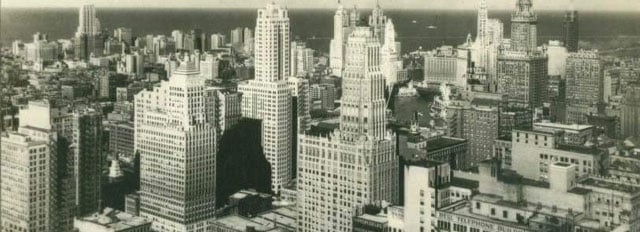
Lost Chicago
In his book, Lost Chicago, author David Garrard Lowe sorts through the
rubble of our city's demolished architectural treasures, and uncovers clues about
how a major metropolis rose out of the Midwestern prairie.
Unchecked development has destroyed countless architectural and historical gems,
but subtle reminders of Chicago's rich and colorful past are scattered across
the city's modern landscape. You just have to know where to look.
In his book, David Lowe muses:
Great cities require tender care. The special quality of Chicago is fragile,
the consequence of all the generations who have dwelt within it, of cultures
carried to Illinois from the four corners of the earth, and of a few rare geniuses.
That special quality can be as mundane as the aroma of sauerbraten in the vanished
Henrici's or in the still-extant Berghoff, as heart-stoppingly beautiful as the
demolished Michigan Square Building's Deco Diana Court or the bronze peacock
feather doors on State Street still proclaiming the entrance to the defunct jewelers
which bore the bird's name, as uplifting as St. Stanislaus Kostka's single surviving
baroque tower. In his memoir A Movable Feast that Oak Park native Ernest
Hemingway wrote: "There is never any ending to Paris and the memory of each person
who has lived in it differs from that of any other." The memory of which Hemingway
writes is inseparable from the buildings which fuel the recollection. There will
never be an ending to Chicago either, unless its precious architectural legacy
is lost.
Did You Know?
John M. Van Osdel made history by opening
the city's first professional architect's office in 1841.
Chicago's first presidential convention was that of the new Republican party
held May 16-18, 1860, in the Wigwam, located at the southeast corner of Lake
and Market streets. Built in five weeks especially for the convention, the two-story
pine structure could hold 10,000 people. Here, the Republicans nominated Abraham
Lincoln of Illinois for President of the United States.
The Union Stock Yards were inaugurated on Christmas Day, 1865. By 1905, the Yards
employed 70,000 workers, received some 17 million cattle, sheep, and hogs a year,
and processed $500 million worth of meat products annually. The animals became
not only steaks and hams, but glue, gelatin, fertilizer, soap, and buttons.
The Chicago Historical Society, organized in 1856, dedicated the first building
constructed specifically for it, in 1868. The elegant building, at Dearborn and
Ontario, along with most of its irreplacable collection of thousands of bound
volumes, pamphlets, maps and letters relating to the early history of Chicago
and the Midwest, was consumed in the Great Chicago Fire.
The area destroyed in 1871 by the Great Chicago Fire was four miles long and
two thirds of a mile wide.
Chicago's 1890 Grand Central train station had a tower at Harrison and Wells
that contained an 11,000 pound bell to warn travelers of the time. Prominent
Chicago architect Harry Weese called the 1971 razing of Grand Central an act
of "wanton destruction."
The entertainment sensation of the 1893 Columbian Exposition was the world's
first Ferris Wheel, designed by George Washington Ferris. The impetus behind
the wheel was Daniel Burnham's challenge for Chicago to have something as "daring
and unique" as the Eiffel Tower, which had been the sensation at the International
Exposition held in Paris in 1889. The 26-story high Ferris Wheel held a total
of 2160 persons.
In 1895, Chicago was determined to have the capital of the United States move
here. The campaign was not successful, but it did result in Chicago being granted
the grandest, most expensive federal building in America.
Sitting outside on the front stairs became a very Chicago thing to do, because
people had small back yards that were usually taken up by their horse.
In the 1920s, Chicago's elegant "movie palaces" were divided into two types,
the "hard top," which traced its ancestry back to the European opera house, and
the "atmospheric," which projected clouds across a night-time sky of sparkling
electric stars.
For
Further Reading
"My
Lost Chicago"
Cultural historian David Lowe reflects on the city of his youth.
Constructing Chicago by Daniel Bluestone. New Haven: Yale University,
1991.
The Chicago School of Architecture: a History of Commercial
and Public Building in the Chicago Area, 1875-1925 by Carl
W. Condit. Chicago: University of Chicago, 1973.
Siftings by Jens Jensen. Baltimore: Johns Hopkins Press,
1999.
History of Chicago Fire Houses of the 19th Century by Kenneth
Little. Chicago: Ken Little.
History of the Development of Building Construction in Chicago by
Frank Randall. Urbana: University of Illinois, 1949.
Chicago's Famous Buildings by Arthur S. Siegel. Chicago:
University of Chicago Press, 1980.

Your $40 Gift Membership will include:
|
























































